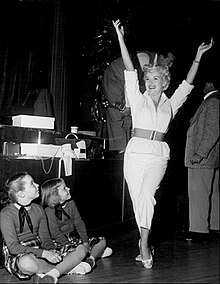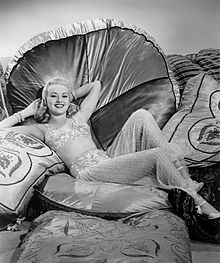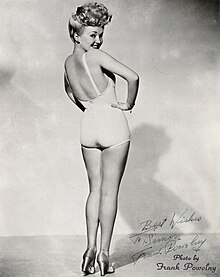


BETTY GRABLE
Elizabeth Ruth Grable (December 18, 1916 – July 2, 1973) was an American actress, pin-up girl, dancer, model and singer.


Grable began her film career in 1929 at age 12 and was later fired from a contract for having signed with a false identification. She had contracts with RKO and Paramount Pictures during the 1930s and appeared in a string of B movies, mostly portraying college students. She came to prominence in the Broadway musical Du Barry Was a Lady (1939), which brought her to the attention of 20th Century-Fox.
She replaced Alice Faye in Down Argentine Way (1940), her first major Hollywood film, and became Fox's biggest film star throughout the next decade. Fox cast Grable in a succession of Technicolor musicals during the decade that were immensely popular, costarring with such leading men as Victor Mature, Don Ameche, John Payne and Tyrone Power. In 1943, she was the number-one box-office draw in the world. Two of her greatest film successes were the musical Mother Wore Tights (1947) and the comedy How to Marry a Millionaire (1953), one of her later films. Grable retired from screen acting in 1955 after she withdrew from her Fox contract, but she continued to per on the stage and on television.
Throughout her career, Grable was a celebrated s e x symbol. Her bathing-suit poster made her the top pin-up girl of World War II, surpa.s.sing Rita Hayworth. The photo was later included in the Life magazine project "100 Photographs That Changed the World". Hosiery specialists of the era often noted the ideal proportions of Grable's legs and thighs (18.5 in (47 cm)), calf (12 in (30 cm)) and ankle (7.5 in (19 cm)). Her legs were insured by her studio for $1 million as a publicity stunt. Describing her film career, Grable said: "I became a star for two reasons, and I'm standing on them."
Early life
Elizabeth Ruth Grable was born on December 18, 1916, in St. Louis, Missouri, the youngest of three children of Lillian Rose (née Hofmann; 1889–1964) and John Conn Grable (1883–1954), a stockbroker. Her second cousin was silent-film actress Virginia Pearson.
Her siblings were Marjorie Lucille Arnold (nee Grable; 1909–1980) and John Karl "Jackie" Grable (1914–1916). The Grable children were of Dutch, English, German, Swiss German and Irish ancestry. Nicknamed Betty as a child, she was pressured by her mother to become a performer. She was entered into multiple beauty contests, winning many and receiving considerable attention. Despite her success, she suffered from a fear of crowds and somnambulism.
Personal life
 Grable's daughters Victoria Elizabeth and Jessica watch her rehea.r.se for her TV debut on Shower of Stars (1954)
Grable's daughters Victoria Elizabeth and Jessica watch her rehea.r.se for her TV debut on Shower of Stars (1954)
Grable married former child actor Jackie Coogan in 1937. He was under considerable stress from a lawsuit against his parents over his childhood earnings, and the couple divorced in 1939.
In 1943, she married trumpeter Harry James. They had two daughters, Victoria Elizabeth "Vicki" Bivens (born 1944) and Jessica Yahner (1947-2016). Their marriage, which lasted for 22 years, was beset by alcoholism and infidelity, and they divorced in 1965.
Grable entered into a relationship with dancer Bob Remick, 27 years her junior, with whom she remained until she died in 1973.
Career
Early career: 1929–1939
A 13-year-old Grable and her mother traveled to Hollywood in 1929, shortly after the stock market crash. In Hollywood, Grable studied at the Hollywood Professional School and the Ernest Blecher Academy of Dance. To obtain jobs for her daughter, Lillian Grable lied about her daughter's age, claiming that she was 15 to film producers and casting agents. That same year, she made her uncredited film debut as a chorus girl in the Fox Studios all-star revue Happy Days (1929).This success led to chorus-girl roles in Let's Go Places (1930) and New Movietone Follies of 1930 (1930).
In 1930, at age 13, Grable (under the pseudonym Frances Dean) signed with producer Samuel Goldwyn, thereby becoming one of the original Goldwyn Girls, along with Ann Sothern, Virginia Bruce, Claire Dodd and Paulette Goddard. As a member of the group, Grable appeared in a series of small parts in films, including the hit Whoopee! (1930), starring Eddie Cantor. Although she received no on-screen credit for her performance, she led the film's opening musical number, titled "Cowboys".
 Publicity photo (1935)
Publicity photo (1935)
In 1932, Grable signed a contract with RKO Radio Pictures, and she was a.s.signed to a succession of acting, singing and dancing cla.s.s.es at the studio's drama school. At age 14, her first film for the studio, Probation (1932), provided her first credited screen role. Over the next few years, she was again relegated to uncredited minor roles in a series of films, many of which became worldwide successes, such as Cavalcade (1933). She received larger roles in The Gay Divorcee (1934) and Follow the Fleet (1936).
After her brief stint as an RKO contract player, Grable signed with Paramount Pictures, which lent her to 20th Century-Fox to costar in the adolescent comedy Pigskin Parade (1936). Despite the studio's effort to introduce Grable to the mainstream movie audience, her performance was overlooked by audiences and critics in favor of Judy Garland. When Grable returned to Paramount, she began a new phase in her career as the studio began casting her in a series of college-themed films in which she usually portrayed a naïve student, such as This Way Please (1937) and College Swing (1938).
In 1939, she appeared opposite her husband Jackie Coogan in Million Dollar Legs, a B-movie comedy that gave Grable her famous nickname. When the film did not become the hit for which Paramount had hoped, the studio released her from her contract and Grable began preparing to leave Hollywood for a simpler life. However, she changed her mind and decided to try Broadway. She accepted Buddy DeSylva's offer to star in his musical Du Barry Was a Lady, starring Ethel Merman and Bert Lahr. The play was an instant critical and audience success, and Grable was branded a newfound star.
Stardom at Fox: 1940–1949
 Grable in a scene from Down Argentine Way (1940)
Grable in a scene from Down Argentine Way (1940)
In a 1940 interview, Grable stated she was "sick and tired" of show business and that she was considering retirement. Soon thereafter, she was invited to go on a personal appearance tour, which she readily accepted. The tour brought Grable to the attention of Darryl F. Zanuck, the head of 20th Century-Fox, who offered her a long-term contract. "If that's not luck, I don't know what you'd call it", Grable said in her first interview after signing with the studio. Zanuck, who had been impressed by Grable's performance in Du Barry Was a Lady, was, at the time, in the midst of casting the female lead in the musical film Down Argentine Way (1940). The role had originally been a.s.signed to Alice Faye, Fox's most popular musical film star, but she had to decline the part due to an unspecified illness. After reviewing her screen test, Zanuck cast Grable as Faye's replacement in the movie. The film was a lavish Technicolor musical and co-starred Don Ameche and Carmen Miranda. Grable's performance of the song "Down Argentine Way" is considered a highlight of the film.
 Grable in the film Tin Pan Alley (1940)
Grable in the film Tin Pan Alley (1940)
Down Argentine Way was a critical and box-office success at the time of its release, and many critics proclaimed Grable to be the successor to Alice Faye. The film's success led to Grable's casting in Tin Pan Alley (1940), co-starring Faye. As the Lily sisters, both Grable and Faye received favorable reviews for their performances. Over the years, rumors have circulated that a rivalry existed between Grable and Faye during filming, but this has been said to be entirely untrue—both actresses denied all accusations of a feud, and each often expressed their admiration for the other. The two reportedly remained friends until Grable's death. After Tin Pan Alley, Grable was teamed again with Ameche in the hit musical Moon Over Miami (1941), which co-starred up-and-coming actress Carole Landis.
 Grable on the cover of Screenland, August 1942
Grable on the cover of Screenland, August 1942
Frank Powolny poster
 Grable's iconic over-the-shoulder pose from 1943 was a World War II bestseller, showing off her "Million Dollar Legs".
Grable's iconic over-the-shoulder pose from 1943 was a World War II bestseller, showing off her "Million Dollar Legs".
In 1943, she collaborated with photographer Frank Powolny for a regular studio photo session. During the shoot, she took several photos in a tight, one-piece bathing suit. One particular pose showed Grable's back to the camera as she playfully smiled looking over her right shoulder. The picture was released as a poster and became the most requested photo for G.I.s stationed overseas. Grable's photograph sold millions of copies, eventually surpa.s.sing the popularity of Rita Hayworth's famous 1941 photo.
Grable died of lung cancer on July 2, 1973, at the age of 56 in Santa Monica, California.
Her funeral was held two days later and was attended by ex-husbands Jackie Coogan and Harry James as well as Hollywood stars Dorothy Lamour, Shirley Booth, Mitzi Gaynor, Don Ameche, Cesar Romero, George Raft, Alice Faye, Johnnie Ray and Dan Dailey. "I Had the Craziest Dream", the ballad from Springtime in the Rockies, was played on the church organ.
She was entombed at Inglewood Park Cemetery in Inglewood, California.

Living room:



































